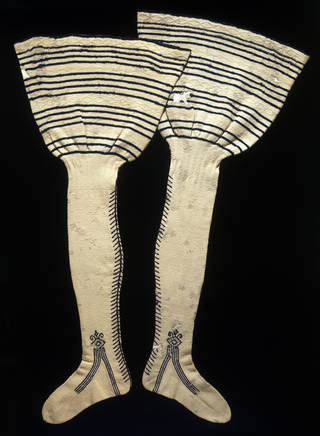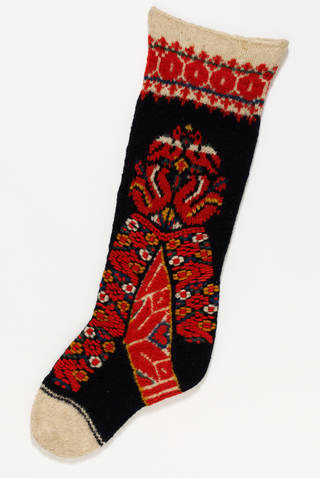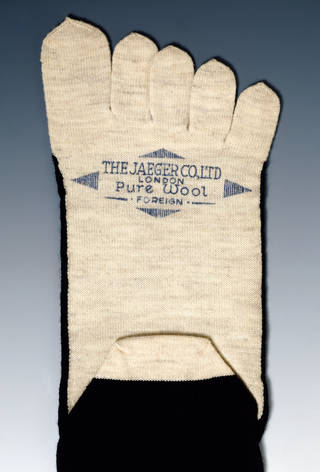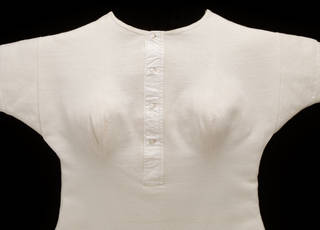Whether socks or swimwear, long johns or leggings, knitting has been as important to what we put on under our clothes as to the clothes themselves. Some of the earliest knitted items were underwear and the growth of the machine-knitting industry was based on underwear's popularity. Even one of our most familiar knitted items – the sweater – developed from underwear. Our extensive collection reveals the many shapes and styles that knitted underwear has taken.
Socks and stockings
Some of the earliest known examples of knitted items are socks. This intricately patterned example was found in Egypt and dates to 1100 – 1300. It is made using 'double-needle' knitting which is the oldest method of knitting in the round and commonly used for making socks or other small items where a tube of knitting is required.

But it's the later interchangeable use of the term 'stocking stitch' with 'plain stitch' that really indicates how important stockings were in the development of knitting. From the 16th century, stockings – also known as hose – were both everyday items and fashionable accessories. A central part of a Tudor nobleman's ornate clothing, stockings were footed (like contemporary tights), worn beneath short breeches and reached all the way up to the waist. They were made in bold colours and often had elaborately decorated inner and outer ankle 'clocks' (decoration at the ankle). Initially the aristocracy wore hose made from cloth but by the mid-16th century, knitted silk stockings were being imported into England from Europe, and soon after were being made in London. Knitted stockings were both more comfortable and offered a better fit than the cloth versions. Stocking-making became a thriving domestic and export trade, with an estimated 90,000 to 110,000 knitters working in the domestic knitting trade in England in 1595.

The stocking-knitting frame was invented by William Lee in the late 16th century and its refinement over time enabled fine silk stockings to be made much quicker, although stockings did also continue to be made by hand. The majority of the 18th- and 19th-century stockings held in our collection are frame-knitted.
There are some surprising geographical variations among traditional stockings. A stocking from Baranya county in southern Hungary – a region known for its ethnic diversity during the Austro-Hungarian Empire (1867 – 1918) – is typical of a style made by German craftsmen living in the region at the time and is the work of a skilled knitter. These stockings were a popular fashion amongst Croatian, or 'Šokci', women, worn as part of their daily and festive dress. The bird and tulip motif is common to the region (the tulip is the national flower of Hungary), while the unusual 'arrow' shape on the heel echoes earlier stocking designs. It's been embroidered with thick wool, probably to provide extra warmth as well as decoration.

The theories of Dr Gustav Jaeger played a vital part in promoting knitted garments as underwear. He extolled the health virtues of woollen clothing, advising the wearing of "sanitary clothing", which was made entirely from wool. In England, his name was licensed by Lewis Tomalin as 'Dr Jaeger's Sanitary Woollen System' and a London shop opened in 1887 (later to become simply known as Jaeger).
Dr Jaeger's original text advocated five-toe socks. A calf-length woollen sock in our collection, made by Jaeger and dating to the turn of the 20th century, has been machine-knitted with individual toes. A 1892 catalogue for the company claimed that:
The woollen material surrounding each toe enables the perspiration to pass away, leaving the inside skin of the toes dry and restored to a condition as normal and free from offense as that of the skin between the fingers of the hand.

Hoisery continued to be made both by machine and by hand and was affected by changing fashions. In the 1920s, as higher hemlines became popular, colourful stockings were made from cotton, wool, silk and rayon, although perhaps the biggest development came in the late 1940s with the introduction of synthetic nylon yarns. In the 1960s, the promotion of shorter skirt lengths by designer Mary Quant inspired another shift – she created her own hosiery brand to meet the demand and tights became fashionable accessories in their own right. The use of elastane in hosiery – more widely known under the trade names of Lycra and Spandex – from the mid 1980s ensured smooth tights that had a great fit.

The changing shape of underwear
Over the centuries, underwear has taken different shapes and styles to the garments that we see today – for example, an 18th-century knitted jacket held in our collection is thought to have been used as underwear. Although it's not known if the jacket was worn by a man or a woman, its decorative pattern – featuring chevrons along the lower edge and with the front edges, centre back and inner and outer sleeve made up of three different kinds of stitches – is identical to a baby's jacket also found in our collection. This suggests that it may have formed part of a layette – a set of clothing worn by a pregnant or nursing woman.

By the time of the Great Exhibition in 1851, the knitting industry in Britain was booming. In addition to the stocking trade, companies were developing new forms of underwear. Seven knitwear manufacturers displayed underwear at the Exhibition, offering an alternative to traditional linen and cotton. An advantage of knitwear was that it could be shaped for better fit, as shown by a women's vest from the mid 19th century in our collection. Intended to provide additional warmth when worn under conventional clothing, it has been knitted to accommodate the bust, waist and hips of its wearer, following the outlines of the corset that would be worn underneath.

As the 19th century progressed, there was a rise in knitted combinations, or all-in-one-vest and drawers, popular with both men and women. The style is closely associated with John Smedley of Derbyshire, a company that had started making woollen hosiery at the end of the 18th century. They developed technology to shape women's combinations at the bust and created a special S-wrap flat opening for the men's versions. The company is also thought to give its name to 'long johns' – a style of two-piece underwear with long legs and long sleeves.
Men's shirts – later known as undershirts or vests – had round necks and a button-front opening. While the basic undershirt or vest shape remained unchanged through most of the 20th century, these shapes were adapted for sportswear and became the basis of the sweater as it’s known today.
In around 1928, John J. Roussel of Paris introduced a bra knitted from silk and cotton. A unique spiral pattern fashions the cups, creating a softly rounded, natural profile. The company claimed that their bras fitted to the body like a glove and were supple, light and quick to put on and take off.

In more recent years, as with stockings, the introduction of elastane knit fabrics have enabled form-fitting styles, increasing the popularity of items such as bodies (one-piece garments covering the torso and crotch) and leggings.
Swimwear
In the early and mid 20th century, swimwear was commonly made from wool and, like underwear, existed in both handmade and mass-produced versions.
The label inside a man's one-piece wool jersey bathing suit from the 1920s boasts that it was made from "the perfect fabric for sensitive skins". While the use of knitted wool allowed for a good fit, the wool would absorb water meaning that this fit was quickly lost when swimming!

One of the 20th century's most infamous swimwear designs was also knitted: the topless bathing suit, designed by Rudi Gernreich (1922 – 85). It consists of a shaped, high-waisted pair of pants made of knitted black and white checked wool with cutaway legs and two crossover black stretch-knit straps. Famously modelled by Peggy Moffitt, the design caused great controversy and generated a massive amount of publicity and notoriety for the designer.

Knitted fabrics still form the basis of most swimwear but as a combination of nylon and spandex, rather than wool. Such fabric can produce a form-fitting garment with stretch that, crucially, maintains its shape in the water.

